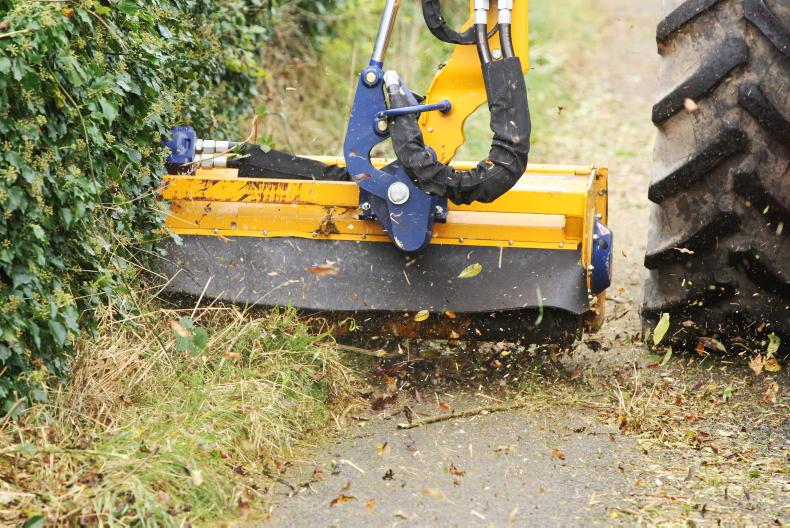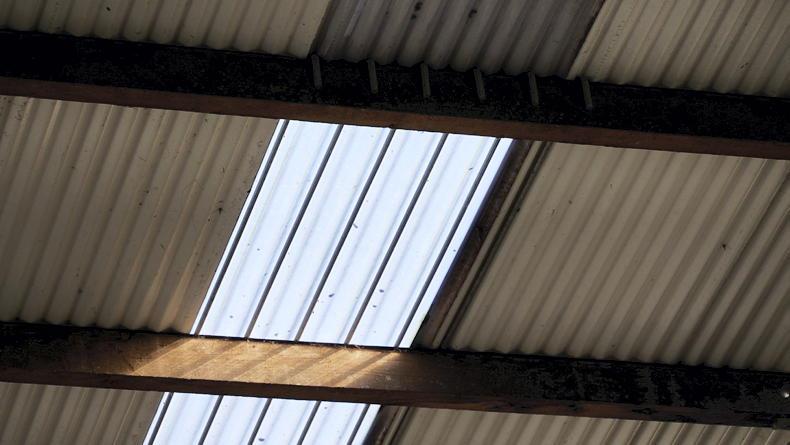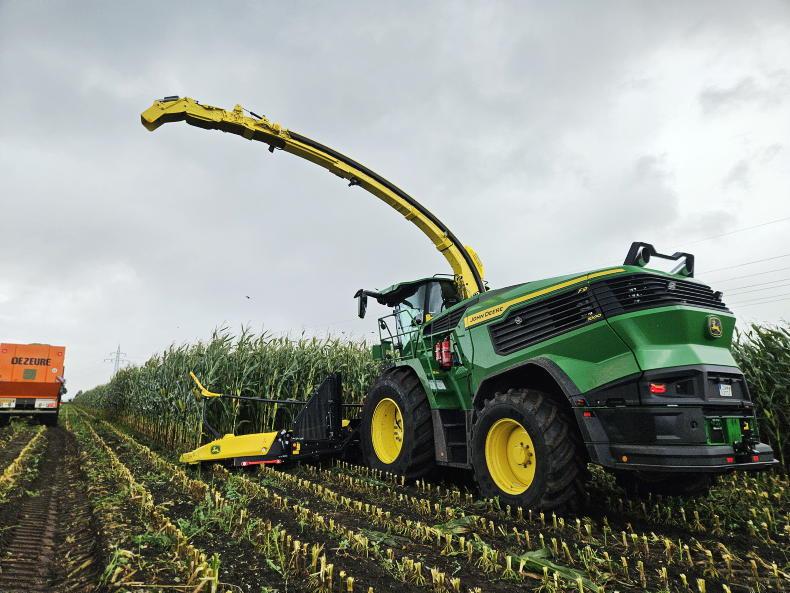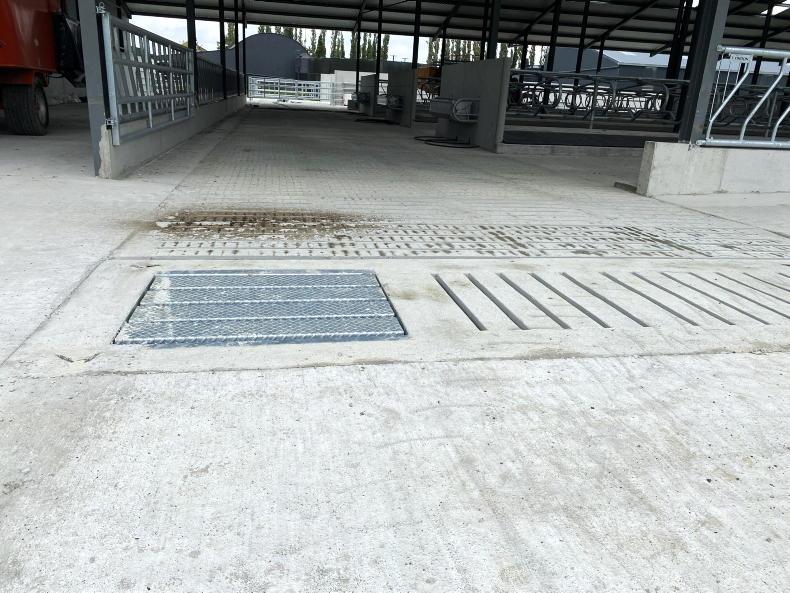Each September, contractors across Ireland begin their seasonal hedge-cutting work with enthusiasm but often lacking some important system cost information.
While the priority is always getting the machine ready for work, all too often time spent sharpening your costing analysis can be time better spent than sharpening the machine’s flails.
Based on charges being quoted, it is now obvious that many contractors decide on the charge for their hedge-cutting operations based on a combination of factors including the amount of work they have done for their farmer client, last year’s rate and what they believe the competition is working for.
For those tendering to local authorities, the focus is unfortunately on the lowest price quote rather than the quality of service provided.
With modern high-cost machinery and increasing labour costs, (if you can get drivers), there is an urgent need to examine machinery costs for all contractor operations.
Machinery is getting more expensive year-on-year; some machines experienced significant price increases during 2023 alone.
That’s why charge rates must be based on all operating costs or else the business cannot be sustainable. And these costs need to be reviewed annually.
Here we examine the weekly and hourly costs associated with operating a contractor hedge-cutting service using a modern 150hp tractor and a contractor specification hedge cutter with 6m reach, joystick control and full support brackets.
Operating costs remain the same irrespective of who the customer is, a farmer, local authority, or a utility such as ESB or Eir.
In establishing the overall costs, we need to break down the individual costs under the following headings:
Tractor costs.Labour costs.Fuel costs.Repair costs.Insurance costs.Hedge cutter machine cost.Tractor costs
The notion of depreciation costs can be difficult to understand so tractor replacement cost is the easiest to understand and it explains how much it costs to own the tractor. Typical tractor replacement costs are based on hours of use.
To buy a typical new 150hp tractor will cost you between €15 and €20/per hour on the clock of your trade-in tractor. We know that when we go to trade in a tractor with 3,000 hours that it costs in excess of €45,000 to change to a new model.
So being generous, tractor ownership cost which covers essentially the depreciation cost comes to €15 per hour because that’s how much it will cost to upgrade to a new model in three years’ time.
Labour costs
When looking at labour costs contractors and farmers need to include all of the costs, your employers’ PRSI and now pension costs, etc.
Each case will be different depending on the tax credits of the employee who will be operating the machine, while some simple examples are always helpful by way of establishing labour costs.
If you are paying a hedge cutter operator €15 per hour gross, that converts to €600 per week before your contributions as an employer.
The overall cost of paying this amount, including your employer contributions, will be in excess of €720 per week.

With modern high-cost machinery and increasing labour costs, there is an urgent need to examine machinery costs for all contractor operations.
That converts to €18 per hour on a 40-hour week. This also means that if you are driving the machine yourself you cannot work for less than €18 per hour, so you need to factor that into the costs, because it’s a real cost.
Fuel costs
You also need to include the cost of travelling to and from the job when looking at fuel costs because, in many cases, the travel operation consumes more fuel per hour than the hedge-cutting itself. A typical contractor hedge cutter outfit will consume seven litres of diesel per hour. At €0.80/l, that equates to €5.60 per hour in fuel cost.
Repair costs
Repair and service costs can be difficult to calculate because the machine age can make a difference.
Generally, repair costs are calculated at between 3% and 5% of the machine buying price spread across the season. In the case of a €100,000 tractor that amounts to €3,000 per season or €3 per hour if we assume annual use of 1,000 hours out of which about 11 weeks or 500 hours is allocated to hedge-cutting work in the season.
Insurance costs
The typical yearly comprehensive insurance cover costs for a modern four-wheel-drive 150hp tractor will be in the region of €1,500. If we assume that the tractor will be doing some other duties during the year, giving 1,000 hours of annual use, which is often not the case, then we allocate a cost of €1.50 per hour for insurance costs.
Total tractor costs per week
Before we include the costs of the hedge cutter, we need to summarise the tractor operating costs as shown in Table 1.
The total tractor operating cost per week at €1,724 converts to a cost of €43.10 per chargeable hour based on a 40-hour week.
Hedge cutter costs
Now we need to examine the costs associated with owning the hedge cutter and this is important as hedge cutter purchase costs have risen significantly in the past two years.
For simplicity, we base the machine cost on a cost of €0.50/€1,000 invested in the machine.
In the case of the contractor specification hedge cutter with 6m reach, joystick control and full support brackets, the purchase price will be in the region of €35,000. This converts into a machine ownership cost of €17.50 per hour, to include all of the machine’s costs, finance, repairs, hydraulic oils, filters, and parts, etc.
Hedge cutter parts have become very expensive and are often overlooked when examining ownership costs. Replacement hammer flails are now costing upwards of €17 each, plus another €6 for a bushing and bolt.
The cost to replace a set of 28 flails on a 1.5m-wide flail head is now in the region of €644. See Table 2.
This is information that all hedge-cutting contractors need to know when planning the services that they offer each year.
If you plan to offer a hedge management service this autumn, then you need to know your costs
If you employ an operator to drive your hedge cutter, then your tractor and hedge cutter outfit need to be earning €2,424 per week to stay afloat. That equates to €60.60 per hour. This rate will allow you to have money to reinvest in a new machine over its lifetime.
It will allow you to pay staff a reasonable wage, but it does not guarantee you a healthy profit.
We know that many service providers are tendering to local authorities and other public bodies at rates considerably lower than this. That option is not one that can support a sustainable business.
If you plan to offer a hedge management service this autumn, then you need to know your costs.
After that, set your margins and invoice your customers as soon as the work is done.
Only then will you have a sustainable contracting business for you, your family, your employees and your customers.
This approach allows you to continue to give your farmer and other clients the quality service that they deserve and that only properly costed machinery contracting services can provide.
Each September, contractors across Ireland begin their seasonal hedge-cutting work with enthusiasm but often lacking some important system cost information.
While the priority is always getting the machine ready for work, all too often time spent sharpening your costing analysis can be time better spent than sharpening the machine’s flails.
Based on charges being quoted, it is now obvious that many contractors decide on the charge for their hedge-cutting operations based on a combination of factors including the amount of work they have done for their farmer client, last year’s rate and what they believe the competition is working for.
For those tendering to local authorities, the focus is unfortunately on the lowest price quote rather than the quality of service provided.
With modern high-cost machinery and increasing labour costs, (if you can get drivers), there is an urgent need to examine machinery costs for all contractor operations.
Machinery is getting more expensive year-on-year; some machines experienced significant price increases during 2023 alone.
That’s why charge rates must be based on all operating costs or else the business cannot be sustainable. And these costs need to be reviewed annually.
Here we examine the weekly and hourly costs associated with operating a contractor hedge-cutting service using a modern 150hp tractor and a contractor specification hedge cutter with 6m reach, joystick control and full support brackets.
Operating costs remain the same irrespective of who the customer is, a farmer, local authority, or a utility such as ESB or Eir.
In establishing the overall costs, we need to break down the individual costs under the following headings:
Tractor costs.Labour costs.Fuel costs.Repair costs.Insurance costs.Hedge cutter machine cost.Tractor costs
The notion of depreciation costs can be difficult to understand so tractor replacement cost is the easiest to understand and it explains how much it costs to own the tractor. Typical tractor replacement costs are based on hours of use.
To buy a typical new 150hp tractor will cost you between €15 and €20/per hour on the clock of your trade-in tractor. We know that when we go to trade in a tractor with 3,000 hours that it costs in excess of €45,000 to change to a new model.
So being generous, tractor ownership cost which covers essentially the depreciation cost comes to €15 per hour because that’s how much it will cost to upgrade to a new model in three years’ time.
Labour costs
When looking at labour costs contractors and farmers need to include all of the costs, your employers’ PRSI and now pension costs, etc.
Each case will be different depending on the tax credits of the employee who will be operating the machine, while some simple examples are always helpful by way of establishing labour costs.
If you are paying a hedge cutter operator €15 per hour gross, that converts to €600 per week before your contributions as an employer.
The overall cost of paying this amount, including your employer contributions, will be in excess of €720 per week.

With modern high-cost machinery and increasing labour costs, there is an urgent need to examine machinery costs for all contractor operations.
That converts to €18 per hour on a 40-hour week. This also means that if you are driving the machine yourself you cannot work for less than €18 per hour, so you need to factor that into the costs, because it’s a real cost.
Fuel costs
You also need to include the cost of travelling to and from the job when looking at fuel costs because, in many cases, the travel operation consumes more fuel per hour than the hedge-cutting itself. A typical contractor hedge cutter outfit will consume seven litres of diesel per hour. At €0.80/l, that equates to €5.60 per hour in fuel cost.
Repair costs
Repair and service costs can be difficult to calculate because the machine age can make a difference.
Generally, repair costs are calculated at between 3% and 5% of the machine buying price spread across the season. In the case of a €100,000 tractor that amounts to €3,000 per season or €3 per hour if we assume annual use of 1,000 hours out of which about 11 weeks or 500 hours is allocated to hedge-cutting work in the season.
Insurance costs
The typical yearly comprehensive insurance cover costs for a modern four-wheel-drive 150hp tractor will be in the region of €1,500. If we assume that the tractor will be doing some other duties during the year, giving 1,000 hours of annual use, which is often not the case, then we allocate a cost of €1.50 per hour for insurance costs.
Total tractor costs per week
Before we include the costs of the hedge cutter, we need to summarise the tractor operating costs as shown in Table 1.
The total tractor operating cost per week at €1,724 converts to a cost of €43.10 per chargeable hour based on a 40-hour week.
Hedge cutter costs
Now we need to examine the costs associated with owning the hedge cutter and this is important as hedge cutter purchase costs have risen significantly in the past two years.
For simplicity, we base the machine cost on a cost of €0.50/€1,000 invested in the machine.
In the case of the contractor specification hedge cutter with 6m reach, joystick control and full support brackets, the purchase price will be in the region of €35,000. This converts into a machine ownership cost of €17.50 per hour, to include all of the machine’s costs, finance, repairs, hydraulic oils, filters, and parts, etc.
Hedge cutter parts have become very expensive and are often overlooked when examining ownership costs. Replacement hammer flails are now costing upwards of €17 each, plus another €6 for a bushing and bolt.
The cost to replace a set of 28 flails on a 1.5m-wide flail head is now in the region of €644. See Table 2.
This is information that all hedge-cutting contractors need to know when planning the services that they offer each year.
If you plan to offer a hedge management service this autumn, then you need to know your costs
If you employ an operator to drive your hedge cutter, then your tractor and hedge cutter outfit need to be earning €2,424 per week to stay afloat. That equates to €60.60 per hour. This rate will allow you to have money to reinvest in a new machine over its lifetime.
It will allow you to pay staff a reasonable wage, but it does not guarantee you a healthy profit.
We know that many service providers are tendering to local authorities and other public bodies at rates considerably lower than this. That option is not one that can support a sustainable business.
If you plan to offer a hedge management service this autumn, then you need to know your costs.
After that, set your margins and invoice your customers as soon as the work is done.
Only then will you have a sustainable contracting business for you, your family, your employees and your customers.
This approach allows you to continue to give your farmer and other clients the quality service that they deserve and that only properly costed machinery contracting services can provide.










SHARING OPTIONS